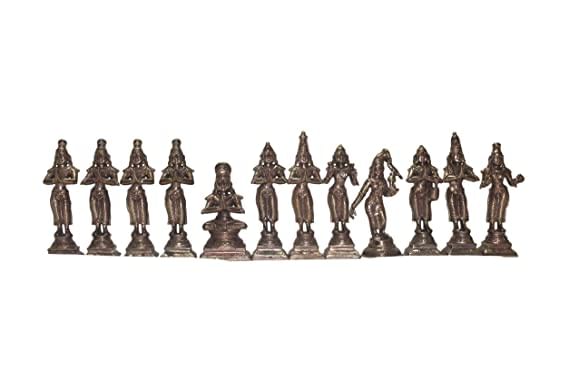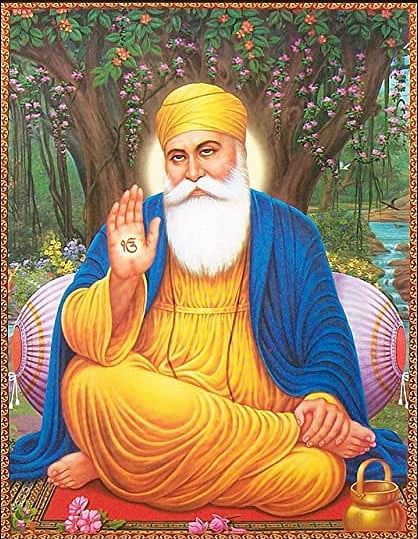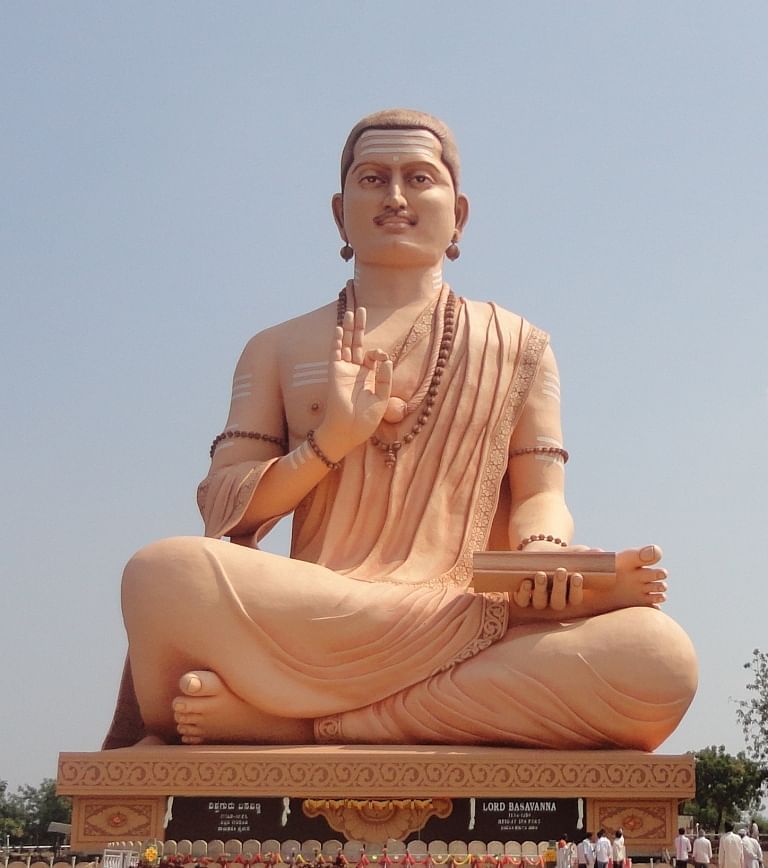Bhakti-Sufi Traditions: Changes in Religious Beliefs and Devotional Texts | History for UPSC CSE PDF Download
Introduction
- From 8th-18th century Bhakti Movement, Islam and Sufi movement played an important role in the history of medieval India.
- The Alvars and the Nayanars were considered as the founder of Bhakti movement in southern India.
- The Alvars were the devotees of Lord Vishnu, while the Nayanars followed Shaivism.
- Both Alvars and Nayanar strongly criticised the social and religious malpractices prevalent in the society.
- Two women saints-Andal of Alvars and Karaikkal of Ammaiyar of Nayanars played a valuable role in giving a new direction to the society.
 12 Alvars
12 Alvars - The Cholas, Pallavas, and Chalukya patronised both Alvar and Nayanar cult.
- Basavanna founded Virashaivas or Lingayats in Karnataka and played a valuable role in the development of his cult.
- Islam was founded by prophet Muhammad in 7th century in Azabia.
The pillars of Islam are:
- Reutors Raima
- Nama
- Ranja
- Zakat
- Hajj
- The holy book of Islam is Quran Shariff. It has been written in Arabic and has 114 chapters.
- According to Muslim tradition Quran is the compilation of those message which god (Allah) had sent to prophet Muhammad between 610-632 at Mecca and Madina through his envoy Archangel Jibris.
- During Medieval period in India Sufism emerged as a powerful movement.Sufis were so called because of the purity (safa) of their hearts. They are in the first queue before god. Some others are of the views that Sufi’s were called so because of their habit of wearing wool (suf).
- Unity in God, complete self-surrender, charity, Ibadat, love for mankinds, etc. are the main teaching of Sufism.
Sufi silsilas begin to emerge in Islamic world.
The important silsilas of Islam are;
- The Chishti Silsila
- The Suhrawardi Silsila
- The Qadiri Silsila
- The Naqshbandi Silsila
Data Gunj Bakhsh, Khwaja Muinuddin Chishti, Shaikh Qutbuddin. Bakhtiyar Kaki, Fariduddin Gunj-i Shakar, and Shaikh Nizamuddin Auliya are some of the prominent Sufi Shaikhs in India.
- Ziyarat meant pilgrimage to the tombs of sufi saints. Its main objective was to seek the spiritual grace from the Sufi.
- Music and dance are an important part of Ziyarat.
- The Sufis believed that music and dance evoke divine ecstasy in human heart.
- The religious gathering of Sufism is known as Sama.
- The qual is an Arabic word which meant ‘saying’. It was sung at opening or closing of the qawwals.
- The devotional worship of god with the ultimate objective of attaining moksha is called Bhakti. The word Bhakti was derived from the root ‘Bhaj’ meaning to adore.
- The Bhaktis who were against the worship of avatars and idol worship are known as saints. Kabir, Guru Nanak Dev ji and successor of Guru Nanak Dev ji are the prominent Bhakti Saints.
 Shri Guru Nanak Dev Ji
Shri Guru Nanak Dev Ji
- The impact of the Bhakti movement on the Indian Society was significant and far-reaching.
- A variety of religious structures like stupas, monastries, temples are found in the sub-continent by the mid-first millennium CE. Textual resources like the Puranas, music in different regional languages, hagiographies of saints were also found. These sources provide us with insight into a dynamic and diverse scenario.
Various Religious Beliefs and Practices:
- A wide range of Gods and Goddesses were found in sculpture as well as in texts. Puranic texts were composed and complied in simple Sanskrit language which could be accessible to women and Shudras, who were generally deprived of vedic learning. Many beliefs and practices were shaped through continuous mingling of Puranic traditions with local traditions. Jagannatha cult of Odisha was the local deity made of wood by local tribal specialists and recognised as a form of Vishnu.
- The local deities were often incorporated within the Puranic framework, by providing them with an identity as wife of the principal deities. For e.g. they were equated with Lakshmi, wife of Vishnu, or Parvati, wife of Shiva. Tantric practices were widespread in several parts of sub-continent. It influenced Shaivism as well as Buddhism.
- The principal deities of the Vedic pantheon Agni, Indra and Soma were rarely visible in textual or visual representations. All other religious beliefs, e.g. Buddhism, Jainism, Tantric Practices ignored the authority of the vedas. The singing and chanting of devotional composition became a mode of worship particularly true for the Vaishnava and Shaiva sects.
Early Traditions of Bhakti:
- Historians classified bhakti traditions into two broad categories i.e. Nirguna (without attributes) and Saguna (with attributes).
- In the sixth century, Bhakti movements were led by Alvars (devotees of Vishnu) and Nayanars (devotees of Shiva). They travelled place to place singing Tamil devotional songs. During their travels, the Alvars and Nayanars identified certain shrines and later large temples were built at these places.
- Historians suggested that the Alvars and Nayanars initiated a movement of protest against the caste system. Nalayira Divyaprabandham composed by the Alvars was described as the Tamil Veda.
- Women devotees like Andal, Karaikkal Ammariyar composed devotional music which posed a challenge to patriarchal norms. Under the patronage of the Chola rulers, large and magnificent temples were constructed at Chidambaram, Thanjavur and Gangai Kondacholapuram.
- Tamil Shaiva hymns were sung in the temples under royal patronage.
The Virashaiva Tradition in Karnataka:
- A new movement emerged in Karnataka led by a Brahmana named Basavanna in the 12th century’.
- His followers were known as Virashaivas (heroes of Shiva) or Lingayats (Wearers of Lingas). Lingayats continue to be an important community in the region to date.
 Basvanna
Basvanna
- The Lingayats challenged the idea of caste, pollution, theory of rebirth etc and encouraged post-puberty marriage and the remarriage of widows.
- Our understanding of the Virashaiva tradlition is derived from Vachanas (literally sayings) composed in Kannada by women and men who joined the movement.
Emergence of Islamic Traditions:
- In the 13th century, Turk and Afghans invaded India and established the Delhi Sultanate.
- Theoretically, Muslim rulers were to be guided by the Ulama and followed the rules of Shari’a.
- Non-Muslims had to pay a tax called Jizya and gained the right to be protected by Muslim rulers.
- Several Mughal rulers including Akbar and Aurangzeb gave land endowments and granted tax exemptions to Hindu, Jaina, Zoroastrian, Christian and Jewish religious institutions.
All those who adopted Islam accepted the five pillars of the faith that are:
- There is one God, Allah, and prophet Muhammad is his messenger.
- Offering prayers five times a day (namaz/salat).
- Giving alms (Zakat).
- Fasting during the month of Ramzan (Sawm).
- Performing the pilgrimage to Mecca (Hajj).
People were occasionally identified in terms of the region from which they came. Migrant communities often termed as Mlechchha meant that they did not observe the norms of caste, society and spoke languages that were not derived from Sanskrit.
The Growth of Sufism:
- In the early centuries of Islam, a group of religious minded people called Sufis turned to asceticism and mysticism in protest against the growing materialism of the caliphate.
- Sufis were critical of the dogmatic definitions and scholastic methods of interpreting the Quran and sought an interpretation of it on the basis of their personal experience.
By the 11th century, Sufism evolved into a well developed movement.
- The suits began to organise communities around the hospice or Khanqah (Persian) controlled by a teaching master known as Shaikh, Pir or Murshid. He enrolled disciples (murids) and appointed a successor (Khalifa).
- Sufi Silsila means a chain, signifying a continuous link between master and disciple, stretching as an unbroken spiritual genealogy to the Prophet Muhammad.
- When Shaikh died, his tomb-shrine (dargah) became the centre of devotion for his followers and practice of pilgrimage or ziyarat to his grave, particularly on death anniversary or urs (or marriage, signifying the union of his soul with God) started. The cult of Shaikh transformed into wali.
The Chishtis in the Sub-continent:
- The Chishtis were the most important group of Sufis who migrated to India.
- The Khanqah was the centre of social life.
- Shaikh Nizamuddin’s hospice on the banks of river Yamuna in Ghiyaspur in the fourteenth century was very famous. The Shaikh lived here and met visitors in the morning and evening.
- There was an open Kitchen (langar) and people from all walks of life came here from morning till late night.
- Visitors who came here included Amir Hasan Sijzi, Amir Khusrau and Ziyauddin Barani.
- Pilgrimage (Ziyarat) to tombs of Sufi saints was common. It was a practice for seeking the Sufis spiritual grace (Barakat).
- The most revered shrine was ‘Gharib Nawaz’, the shrine of Khwaja Muinuddin at Ajmer.
- This shrine was funded by Sultan Ghiyasuddin Khalji of Malwa. Emperor Akbar visited several times and constructed a mosque within the compound of dargah.
- Specially trained musicians or qawwals performed music and dance to evoke divine ecstasy.
- Baba Farid’s compositions in the local language were incorporated in the Guru Granth Sahib.
- In Karnataka, the Sufis were inspired by the pre-existing bhakti traditions and composed Dakhani, Lurinama (lullabies) and Shadinama (wedding songs).
- Sultans of Delhi always preferred the Sufis although there were instances of conflict between them.
New Devotional Paths in Northern India:
Kabir was a poet-saint of 14th-15th centuries.
- Kabir’s verses were compiled in three distinct traditions
- The Kabir Bijak is preserved by the Kabirpanth in Uttar Pradesh.
- The Kabir Granthavali is associated with the Dadupanth in Rajasthan.
- Many of his verses were included in the Adi Granth Sahib.
- Kabir described the ultimate reality as Allah, Khuda, Hazarat and Pir. He also used terms from vedantic traditions, like alakh, nirakar, brahmin, atman, etc.
- Kabir accepted all types of philosophy i.e. Vedantic traditions, Yogic traditions and Islamic ideas.
- Kabir’s ideas probably crystallised through dialogue and debate.
The message of Guru Nanak is spelt out in his hymns and teachings, where he advocated a form of Nirguna bhakti.
- According to Guru Nanak, the absolute or ‘rab’ had no gender or form. His ideas expressed through hymns called ‘Shabad’ in Punjabi.
- Guru Arjan compiled Guru Nanak’s hymns along with the hymns of Baba Farid, Ravidas and Kabir in the Adi Granth Sahib. Later, Guru Gobind Singh included the compositions of Guru Tegh Bahadur and this scripture was known as the ‘Guru Granth Sahib.’
- Mirabai was a famous woman-poet of Bhakti tradition. She composed many songs that were characterised by intense expression of emotions.
- Mirabai’s song inspired poor and low caste people in Gujarat and Rajasthan.
- Shankaradeva in the late fifteenth century was a leading proponent of Vaishnavism in Assam.He emphasised the need for ‘Naam Kirtan’ and encouraged the establishment of ‘Satra’ or monas tries and ‘naam ghar’ or prayer halls. His major compositions include the ‘Kirtana-ghosha’.
Religious Traditions of Northern India:
- Religious traditions included a wide variety, written in several different languages and styles. These ranged from the direct language of the Vachanas of Basavanna to the Persian farman of the Mughal Emperors.
- Historians have to understand that religious traditions like other traditions, are dynamic and change over time.
Some Key terms to remember:
- Great Tradition: The cultural practices of dominant social categories were called the Great Tradition.
- Little Tradition: These were that tradition which do not correspond with the Great Tradition.
- Integration of cult: Modes of worship.
- Jagannatha: The lord of the world.
- Tantricism: Worship of the golden.
- Alvar: Devotees of Vishnu in South India.
- Nayanars: Devotees of Shiva in South India.
- Saguna Bhakti: Bhakti focused on the worship of Shiva, Vishnu and Devi.
- Nirguna Bhakti: Worshipping a shapeless or an abstract form of God.
- Tavaram: Collection of Poems in Tamil.
- Imam: Religious scholars of Islamic studies.
- Sharia: Law of governing the Muslim community.
- Maktubat: Letters written by Sufi-saints.
- Tazkiras: Biographical account of saints.
- Sangat: Religious society under which the followers assembled both in mornings and evening to listen Guru’s sermons.
Timeline:
1206 – Delhi Sultanate was set up
1236 – Death of Shaikh Muinuddin Chishti
1469 – Birth of Guru Nanak Dev Ji
1604 – Compilation of Guru Granth Sahib
1699 – Foundation of Khalsa Panth by Guru Gobind Singh Ji Some Major Religious Teachers in the Subcontinent. This Timeline indicates the period of the major saints and reforms era
500-800 – CE Appar, Sambandar, Sundaramurti in Tamil Nadu
800-900 – Nammalvar, Manikkavachakar, Andal, Tondaradippodi in Tamil Nadu The teaching of these saints influence entire the people of India.
1000-1100 – Al Hujwiri, Data Ganj Bakhsh in the Punjab, Ramanujacharya in Tamil Nadu
1100-1200 – Basavanna in Karnataka
1200-1300 – Jnanadeva, Muktabai in Maharashtra; Khwaja Muinuddin Chishti in Rajasthan; Bahauddin Zakariyya and Fariduddin Ganj-i Shakar in the Punjab; Qutbuddin Bakhtiyar Kaki in Delhi.
1300-1400 -Lai Ded in Kashmir, Lai Shahbaz Qalandar in Sind; Nizamuddin Auliya in Delhi; Ramananda in Uttar Pradesh; Chokhamela in Maharashtra; Sharafuddin Yahya Maneri in Bihar
1400-1500 – Kabir, Raidas, Surdas in Uttar Pradesh; Baba Guru Nanak in the Punjab; Vallabhacharya in Gujarat; Mir Sayyid Muhammad Gesu Daraz in Gulbarga, Shankaradeve in Assam; Tukaram in Maharashtra.
1500-1600 – Sri Chaitanya in Bengal; Mirabai in Rajasthan; Shaikh Abdul Quddus Gangohi, Malik Muhammad Jaisi, Tulsidas in Uttar Pradesh.
1600-1700 – Shaikh Ahmad Sirhindi in Haryana; Miyan Mir in the Punjab.
|
210 videos|855 docs|219 tests
|
FAQs on Bhakti-Sufi Traditions: Changes in Religious Beliefs and Devotional Texts - History for UPSC CSE
| 1. How did the Bhakti-Sufi traditions bring about changes in religious beliefs? |  |
| 2. What are some examples of devotional texts associated with the Bhakti-Sufi traditions? |  |
| 3. How did the Bhakti-Sufi traditions influence the religious landscape of medieval India? |  |
| 4. What are the key differences between the Bhakti and Sufi traditions? |  |
| 5. How did the Bhakti-Sufi traditions contribute to social and religious harmony in medieval India? |  |





















